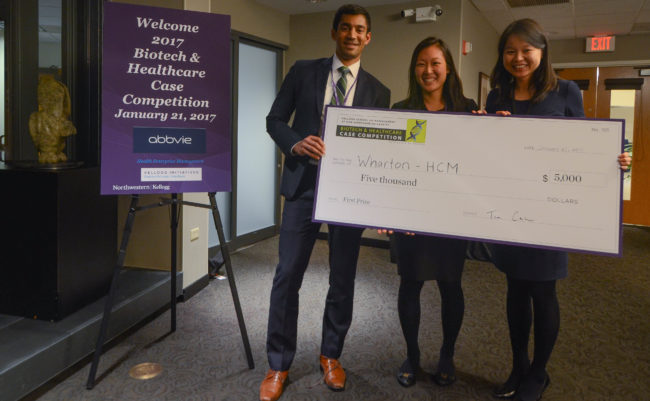
Notes from the Kellogg Healthcare Case Competition
This weekend Kellogg hosted the 14th annual Kellogg Biotech and Healthcare Case Competition. I help run the event.
A total of sixty teams applied, and we selected eleven to compete. Representing ten different business schools, the list included Wharton, Chicago Booth, Tuck (Dartmouth), MIT Sloan, HEC Paris, Judge (Cambridge), Fuqua (Duke), Olin (Washington University), Berkeley Haas and Kellogg.
This year’s case focused on reducing infant mortality in Nigeria by expanding adoption of chlorhexidine for use on the umbilical cord stump. We created the case in partnership with USAID’s Center for Accelerating Innovation and Impact, and we asked the teams to propose ways to increase use of the antiseptic gel in Nigeria.
Here are some observations from the event. You can read more about it here.
Improving Healthcare Isn’t Easy
People tend to simplify healthcare issues. In the United States, for example, if people just ate better, stopped smoking and got regular exercise we would reduce medical costs and have better health outcomes. Of course, getting people to actually change those behaviors is a challenge.
The chlorhexidine case certainly highlighted this dynamic. The idea is as straightforward as it comes: chlorhexidine is cheap, simple to produce and transport, easy to use, and highly effective. Still, getting people to adopt it is difficult. Any proposed plan has to address multiple stakeholders and be a sustained effort.
What Is A Life Worth?
Healthcare is at times an economic choice. This yields challenging but necessary questions. What is a life worth? Is a costly therapy justified?
In many countries, people quantify the value of a life by looking at quality-adjusted life years. If a therapy is inexpensive and highly effective, it will have a low cost per quality-adjusted life year. In developed countries, $50,000 per quality-adjusted life year is generally considered reasonable.
Chlorhexidine can save a life for about $5. If the baby would then have 50 good years, the cost per quality adjusted life year would be just ten cents. Nonetheless, some countries struggle to afford it.
This is a difficult issue to consider. As a global community, is it right to pay $50,000 for a year of life in one country, when another country can’t afford a therapy that costs just ten cents per quality life year?
Business School Students Are More Similar Than Different
If you follow the business school world, you know that schools have reputations. Chicago Booth is highly quantitative. Kellogg students are strong team leaders. Each school has its own hallmark of identity.
The reality is that all business school students have a lot in common. In general, they are sharp, quantitative, enthusiastic and well-spoken. That certainly was the case this weekend. We disguised the schools for the judges, using colors instead of school names, and by the end of the day the judges had no idea where their teams were from.
Use an Agenda
One of the easiest ways to improve a presentation is to use an agenda and refer back to it frequently. Some teams did this and others did not. Without an agenda, your audience doesn’t know what is coming next. At times during the competition, the judges were confused. Was the presentation over? Or was there more to come?
An agenda helps your audience track the story. It is a simple tool that will make any business presentation better.
Check the Room
Teams presented their plans to the judges in a large room with a screen on one side and a podium on the other. Many teams struggled to figure out where to stand and present from. They walked into the room, hesitated and then got settled. Some teams stood on one side, some stood on the other. Some had people on both sides. It was awkward at times.
Before doing a presentation, it is always good to check the room. What is the space? Where is the best place to present? Where should other people on the team stand? Just stop by early and look at the layout. You’ll be more comfortable and positioned for success.
For next year’s competition, you should tackle the issue of getting Dominican Republicans to use seatbelts. From what I am hearing in the media, that is not endemic in their culture and a large reason why they keep losing our best ballplayers to automobile crashes. This sounds a little similar to the way you describe the healthcare solution sales pitch in this year’s conversation.